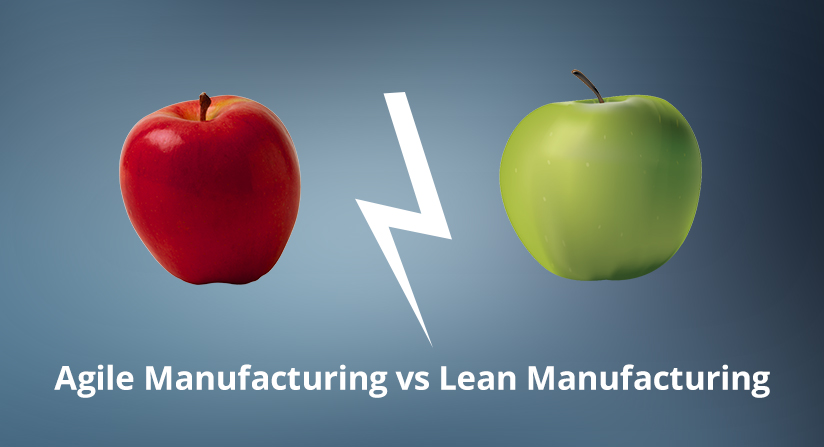Lean and Agile are two of the most commonly discussed and debated principles of manufacturing, particularly when there’s a transformation underway. While there are many similarities between the two, manufacturers need to have a clear understanding of how and when to put them into practice.
If you look close, both Lean and Agile appear the same. Both of these manufacturing processes aim to shorten production cycles so that final goods hit the market faster. So where do they differ? Let’s see.
What is Agile Manufacturing?
The theories behind physics and mathematics, tested over years of practice, form the foundation of manufacturing and the supply chain. But sometimes even the simple and basic ideologies are lost in the day-to-day realities of running a business. Meanwhile, newer principles that support even more sophisticated agility fail to get the attention they deserve. As a result, the vast majority of manufacturing organizations have enormous performance improvement potential in terms of cost, inventory, and service.
The theories and concepts which make up the agile manufacturing practice are:
Queuing theory
The relevant underpinning of supply chain and operations management is the queuing theory, which recognizes that any system involving at least one conversion stage has finite throughput capacity and always suffers from waits. The reality is the same regardless of whether you look at a supermarket checkout lane, a factory production line, a distribution channel, or even a new product development process: if demand is more than the capacity, the queue will exceed open-endedly. Even if the average demand is below 100 percent capacity, there still is a backlog. Variability in the rate of arrivals at a workstation and its processing time will lead to demand spikes and unused capacities. This causes the development of a queue with a finite average length. However, if there is plenty of spare capacity, the line may not be noticeable.
Forecast-induced variability
Forecasting is a notoriously sketchy activity. Achieving 80 percent accuracy often is considered world-class. This means that most medium- and low-volume stock-keeping units (SKUs) achieve somewhat higher inaccuracies.
Manufacturing or purchasing schedules based on inaccurate SKU forecasts lead to the production of unbalanced stocks that can damage service. Unfortunately, changes cost money because every factory schedule that is interrupted by an expedited item suffers from forecast-induced variability.
Demand-driven agility
True agility is designed into a supply chain. It can be defined as the ability to be genuinely flexible and autonomously responsive to real demand and its variations with minimal cost-generating buffers that best serve both the company and its customers.
Demand-driven agility positions planned and carefully sized inventories in the supply chain that break the demand dependencies, absorb the variation, and minimize lead times. These inventory positions are replenished using only demand, not a forecast.
The future agile manufacturing
The concepts behind demand-driven agility are not new; they have been around since 1961 and were applied even earlier at Toyota. The current relative scarcity of demand-driven agility is due to its counterintuitive nature and the difficulty of implementing it across modern enterprises without appropriate and robust software support.
The outlook for demand-driven agility, however, is very positive. And, with the emergence of functionality-rich, scalable, and globally tested software— specially designed to support demand-driven agility—it is now possible to quickly and inexpensively simulate, pilot, and implement these techniques both within and across company boundaries.
What is Lean Manufacturing?
Originally known as just-in-time (JIT) production, it thrived in Japan in the 1960s and 1970s, then migrated across the globe in the 1980s. As JIT gained more believers, numerous books and articles were written on the approach. These titles discussed speed to market, cycle time, lead time, quick response manufacturing, and more—each with its specific point of view. Though the concepts and methodologies echoed those of JIT, the label of choice became “lean.”
Lean was welcomed by its target industrial audience partly because the term sounded just right and also because of the incessant quest to find the answer to “what’s next?” Lean was in, while JIT was shop-worn—so much so that, by the next decade, the business press abandoned its use in reference to production.
Lean is an everyday term in the supply chain management realm. Lean production can be described as the production which emphasizes the minimization of the amount of all the resources (including time) used in the various activities of the enterprise.
Beyond that, lean management is a concept rooted in continuous improvement—or, as I like to call it, a journey. It’s not about the destination because the destination is constantly changing as customers, needs, products, and businesses evolve. The journey to be the best, to design a great experience, and to deliver customer value is an ongoing one.
Lean management aligns resources to achieve an organization’s purpose and engages everyone in designing processes to continuously solve problems, improve performance, and achieve purpose while consuming the fewest possible resources.
Lean manufacturing in real-life
When a business is considering lean manufacturing—either as a new initiative or as reprised JIT—it’s necessary first for company decision-makers to champion lean as a major initiative that will involve large-scale training and complex implementation. Enthusiastic leaders even may serve as the highest-echelon teacher in an all-out train-the-trainer effort. Once the pursuit is going well, it’s time to refocus on the many critical issues always facing busy executives—some of which likely have been neglected during the lean run-up. This is when these leaders must back off from dutiful lean involvement and delegate its management down a level.
Once in the operations silo, people tend to forget the fact that lean is inherently strategic and a matter of time-based competition. Suddenly, lean is promoted and defined as the elimination of waste. As a result, the method has less connectivity to other important departments, such as finance, marketing, and sales. Even worse, lean is pursued for internal efficiency rather than customer-focused effectiveness, and as a result, has only tenuous links to end customers.
Efficiency fares poorly when stacked up against effectiveness. For example, think of how it feels when all the supermarket checkout lanes are busy or too many staff people are off filling shelves instead of cashiering and packaging our purchases. We want efficiency, but demand flexibility: ready adaptation to our unpredictably up-and-down usage patterns. Otherwise, we take our business elsewhere.
In a factory setting, this might look like all operatives producing, all machines carving and crunching, and equipment and human resources keeping busy and using space wisely. Such efficiency is a source of pride for those involved. Yes, there’s high-capacity use; but, there’s also low-capacity availability. A truly lean enterprise—built and run for lean effectiveness—requires methods for delivering a flexible, quick response. This is aided by two of lean’s core practices—capability for fast setup and changeover and having a multi-skilled workforce. These competencies enable rapid switching among scheduled products or orders.
As for lean’s issue of low availability, part of what is required here is a shift in the way lean is practiced in operations. Competitive, customer-focused lean rejects full capacity use. Surge capacity, redundant and idle (but at the ready) equipment, a multiply-cross-trained workforce, and on-call backup labor—all of these and more are requisites of best-practice lean. At the same time, inadequate lean metrics need an overhaul to reach beyond production and out to customers. This should include minimal backlogs, few back orders, and empty warehouses in make-to-order production, but full retail shelves in replenishment manufacturing.
So, what next?
For a lean shift to take place, it’s essential to redefine and promote lean as time-based competition. That term should populate company walls and documents. All other lean terms should remain intact, but be subordinate to the main themes of time and the customer.
To achieve this shift of terminology accompanied by a sea change in lean practices requires a dedicated campaign. Initially, it should be led by operations and then taken up jointly with sales, marketing, and finance. The launch should begin by promoting the whys and hows of tapping into lean’s large potential for dramatic competitive advantage. Each success should show up quickly and convincingly—first as reductions of channel inventories and, before long, in winning more customer orders and retaining good customers longer. Finally, success appears as a sign of trouble for one’s competitors.
Lean and agile organizations
Companies aiming to reach higher levels of maturity through advanced manufacturing practices require a practical and proven approach to change transformation. Such organizations can become more demand-driven, improve margins, and increase market share.
However, first and foremost they must be both lean and agile. The lean principles of operational excellence, efficiency, and eliminating waste are essential to successful advanced manufacturing practices —as is agility, which emphasizes planning and controlling variability. Lean and agile companies are an organization’s single-most-important competitive weapon for ensuring that customers are being profitably served through the right channels and with the right product mix.
Only when organizations are truly lean and agile can the process help companies recalibrate business strategy through continuous re-planning. Lean and agile organizations involve stakeholders from all key departments to come together in a formal, structured cadence to produce an integrated company game plan. This approach reconciles the views of all functional areas simultaneously, making sure the strategy aligns with strategic business objectives.
Many companies fail to realize the value of advanced manufacturing practices because stakeholders are operating in silos, entrenched in resolving day-to-day priorities, and putting out fires. Perhaps each department has its own version of the plan and thus decisions are made as an independent functional group.
Technology aids with automation and the elimination of non-value-added activities, such as manual time and effort spent collating and reviewing data from multiple places.
A shared vision
As a key leader and influencer at your organization, you must accept your role in helping the entire business reach a better place. Recognizing and addressing the basic issues of differing agendas and mismatched expectations can help these two vital functions to mix.
Manufacturing ERP solutions such as OptiProERP, which are certified by SAP guarantees quality and correct business process re-engineering.
Find out how OptiProERP can transform your business by emailing us at optiproinfo@optiproerp.com or by requesting a product overview.
Follow Us








